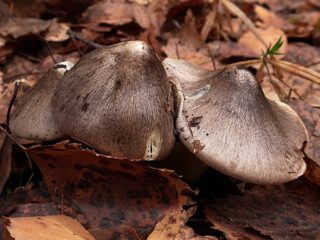Content
Cystoderma flaky is a lamellar edible mushroom from the Champignon family. Due to its similarity to toadstools, almost no one collects it. However, this rare mushroom is useful to know, and if there are few others, then you can replenish your basket with such a specimen.
What does cystoderm flaky look like?
Cystoderma fragrant or flaky umbrella (these are other names for the mushroom) has light flesh with a faint taste of wood. Consists of a cap and a stem. On the reverse side of the cap, frequent plates of cream or light brown color are visible. Reproduces by white spores.
Description of the cap
The evolution of the cap of the cystoderm flaky occurs as follows: cone-shaped (hemispherical) in youth it becomes curved outward with a central tubercle in adulthood with a diameter of up to 6 cm. The color is yellowish or gray-pink, but fades to white over time. The dry matte surface is covered with white fine-grained powder of ripening spores. A fringe in the form of hanging flakes is visible at the edges of the cap.
Description of the leg
The hollow inside stalk of cystoderm flaky has a height of 3-5 cm and a diameter of up to 5 mm. Divided by a ring with a lapel into two halves: the upper one is light and smooth, the lower one is pimply.
Is the mushroom edible or not?
Does not have high-quality taste characteristics. In terms of nutritional value it belongs to category 4. Can be used to prepare soups and other dishes. It is recommended to boil for at least 15 minutes. The broth is drained.
Where and how does it grow
Cystoderma grows on the ground in moss or on fallen leaves and needles in mixed pine and coniferous forests. Prefers chalky soils. Distributed mainly in North America, Central Asia, and Europe. In Russia it is a rare mushroom. There are single specimens and group growths. The growth period is the second half of August and until November.
Doubles and their differences
There are several species of this family:
- Cystoderma amianthaceae. Conditionally edible. It is distinguished by a browner color and watery pulp. The leg does not have a ring.
- Cystoderma red. It is distinguished by a reddish or orange tint, a larger cap and a thick stem. Has a mushroom smell. Edible. It needs to be boiled.
Important! Before collecting, you need to study the distinctive features or upload a photo to your phone so as not to confuse it with a poisonous mushroom.
- Death cap. Poisonous. Differences: A taller and thicker leg grows from an ovoid white volva. The ring-skirt with fringe on the leg is directed downwards.
Conclusion
Cystoderma flaky is an exotic mushroom. Therefore, it is better for novice mushroom pickers not to risk collecting them. Only an experienced lover of quiet hunting can be sure that he has taken the “correct” specimen.













